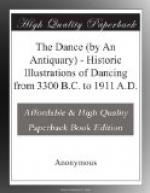[Illustration: Fig. 34.—A tumbler, as caryatid. Rouen Cathedral, 13th century.]
In the fourteenth century, from a celebrated MS. (2 B. vii.) in the British Museum and other cognate sources we get a fair insight of the amusement afforded by these dancers and joculators. In the illustration (fig. 35) we get A and C tumblers, male and female; D, a woman and bear dance; and E, a dance of fools to the organ and bagpipe. It will be observed that they have bells on their caps, and it must have required much skill and practice to sound their various toned bells to the music as they danced. This dance of fools may have suggested or became eventually merged into the “Morris Dance” (fig. 50) of which some account with other illustrations of “Comic Dances” will be given hereafter. The man dancing and playing the pipes with a woman on his shoulder (fig. 36), the stilt dancer with a curious instrument (C), and the woman jumping through a hoop, give us other illustrations of fourteenth century amusements.
[Illustration: Fig. 35.—14th century dancers. A and C are tumblers; B, tumbling and balancing to the tambour; D, a woman dancing around a whipped bear; E, jesters dancing.]
[Illustration: Fig. 36.—A, man dancing and playing pipes, carrying a woman; B, jumping through a hoop; C, a stilt dance. 14th century.]
CHAPTER V.
SOCIETY DANCING FROM THE FIFTEENTH CENTURY.
[Illustration: Fig. 37.—Italian dance. From an engraving, end of 15th century, attributed to Baccio Baldini.]
Concerning the dance as a means of social intercourse, it does not appear to have been formulated as an accomplishment until late in the thirteenth century, and at a later date was cultivated as a means of teaching what we call deportment, until it became almost a necessity with the classes, as is shown by the literature of that period. The various social dances, such as the Volte, the Jig and the Galliard, although in early periods, not so numerous, required a certain training and agility. These, however, soon became complicated with many social and local variations, the characteristics of which are a study in themselves. The dances (figs. 37 and 38) in a field of sports, from an Italian engraving of the fifteenth century, show us nothing new; indeed, with different costumes it is very like what we have from Egypt (fig. 3), only a different phase of the action, and the attitude of this old dance is repeated even to our own time.
[Illustration: Fig. 38.—Italian dancing, the end of the 15th century.]
In the Chamber dance by Martin Zasinger (fig. 39), of the fifteenth century, no figures are in action, but we see an arrangement of the guests and musicians, from which it is evident that the Chamber dance as a social function had progressed and that the “Bal pare,” etc., was here in embryo.
The flute and viol are evidently opening the function and the trumpets and other portions of the orchestra on the other side waiting to come in.




